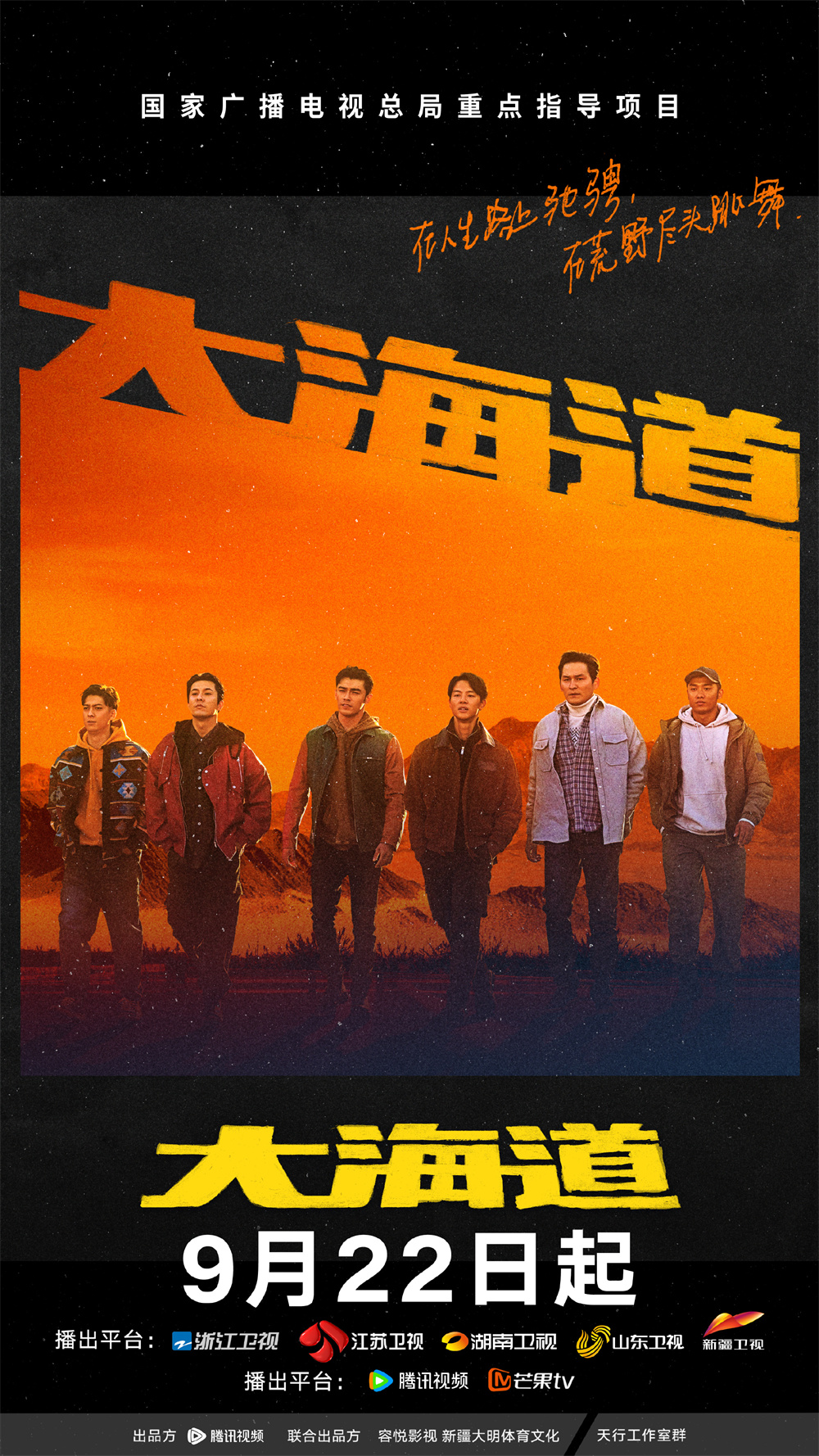
Recently, the newly released TV series "The Great Desert Road" caught my attention. As a "main melody" work, it features a remarkably well-presented story and impressive audiovisual effects, and the cultural scenery of Xinjiang leaves a lasting impression.
"The Great Desert Road," produced by Tencent Video in collaboration with Rongyue Film and Television and Xinjiang Daming Sports Culture, is a key broadcast series celebrating the 75th anniversary of the founding of the People's Republic of China, themed "Walking with the Times, Being One with the People." It is closely guided and launched by the National Radio and Television Administration, jointly filmed by the Publicity Department of the Xinjiang Uygur Autonomous Region Party Committee. This extensive background has made the show a point of interest since its preparatory phase, with its significant mission of showcasing the new era of Xinjiang to audiences.

Poster of "The Great Desert Road"
The name "The Great Desert Road" may be unfamiliar to many viewers. It refers to the ancient route between Dunhuang, Hami, and Turpan, known to be the shortest. Its establishment and use began in the Han Dynasty, and after the Tang Dynasty, official utilization gradually ceased, leading to its disappearance from the public's view, remaining only as a memory of the Silk Road in history. As a channel that connected Eastern and Western civilizations in ancient times, the Silk Road has long been a focus in academia due to its colossal role in the history of human cultural exchange. With the deepening of research, most sections of the Silk Road have had their historical mysteries unveiled, yet the specific route of the Great Desert Road remains obscured in the sands of time. "The Great Desert Road" tells the contemporary story of Xinjiang youth centered around this route.
The story unfolds with Lin Hao, a Han youth growing up in Xinjiang, and Halik, a Uyghur youth. Lin Hao, born in a mining area, is rebellious and desperately aspires to participate in the world's top motorcycle rally; Halik, on the other hand, is a sunny, kind-hearted young man dedicated to motorcycle sports. The two meet during a desert rescue operation in the uninhabited area of the Great Desert Road and gradually become brothers who appreciate each other, moving from rivals to friends.
They agree to ride their motorcycles out of the desert and into the world. Despite enduring numerous hardships along their dream-chasing journey—such as emotional trauma from losing friends and physical pain—they never give up. As the rally progresses, deeper cultural and personal connections are unearthed, prompting them to contemplate the true meaning of freedom, dreams, and responsibility.
Simultaneously, the drama introduces other characters, such as Shen Di, a cultural tourism entrepreneur from the West; grassroots cadre Xilin, dedicated to developing a desert town; and businessman Zhao Youwei, who sets up the rally stage in Xinjiang. These individuals become connected through motorcycles and embark on a journey of intertwined destinies.

Still from "The Great Desert Road"
In the series, Yin Fang delivers an consistently stable performance as the male lead. His portrayal of a passionate and innocent youth feels perfectly suited to the character. A pleasant surprise is the actor Wa Er, whom I previously saw in "The Sands of the Sea" and "Restart: The Extreme Sea Listening Thunder," but didn't leave a strong impression. In this series, he plays Halik, a character inspired by the Chinese motorcyclist Zakir Yakup, a biker from the Hami Wubao Great Desert Road team. Zakir has participated in multiple Dakar Rallies, achieving remarkable results. His journey as a racer is truly inspiring. Wa Er's portrayal diverges from a glorified, heroic archetype, instead presenting Halik as sunny, kind, and endearingly crafty. Wa Er's genuine and natural performance sheds the typical urban, idol-like persona often seen in modern storytelling.


Still from "The Great Desert Road"
Moreover, the audiovisual language in the first episode offers surprises. At the outset, viewers are greeted with the magnificent landscapes of Xinjiang's deserts. The series employs expansive natural scenery of Xinjiang as a backdrop, showcasing endless deserts, towering mountains, and the mysterious Yadan landforms, creating visually striking moments.
Following this, a segment set in a minority village brings viewers into Wa Er's daily life, from his home to riding his motorcycle and rallying friends in the village. The camera unfolds, capturing everyday life in the village—the elderly sunbathing while drying carpets, children playing pool, pregnant women soaking in the sun, villagers engaged in tasks, and fruit vendors bustling about—creating a vivid tableau. Particularly captivating is a group of ethnic youth riding motorcycles through shaded grapevine corridors; the sunlight dapples on their skin as their laughter and shouts echo, making it a delightful spectacle.

Still from "The Great Desert Road"
Additionally, the series integrates local music and cultural elements from Xinjiang, enriching the overall audiovisual experience. The soundtrack heavily features traditional Uyghur instruments; whenever this exotic music resonates, it instantly immerses the audience.
While watching the first two episodes, I had a nostalgic experience reminiscent of "The Mountains and Seas of Emotion": a narrative that conveys essential emotions without sacrificing authenticity. In "The Great Desert Road," the central theme revolves around two youths pursuing their motorcycle dreams, with underlying themes of local economic development and guiding the community towards a better life. Local grassroots cadres lament the struggles of relying on the land for resources, feeling distant from modern urban development, and overwhelmed with fears about local advancement. Nonetheless, they remain committed to developing cultural and tourism sectors by leveraging the historical value and breathtaking beauty of the Great Desert Road.
In the series, various characters—such as tour operators, local grassroots cadres, and village youth—make significant efforts to attract tourists and boost the local economy. Lin Hao's father, to meet tourists' requests for train viewings, endures his illness to repeatedly showcase steam trains, leading to a heart attack; cadre Hao Qiang tightens his belt and reaches into his own pockets to fund the red date festival, with worn-out socks highlighting his sacrifices; Shen Di is a cunning cultural tourism entrepreneur, yet courageous in facing local social affairs and responsibilities. The cumulative efforts of these characters will undoubtedly return benefits to this vibrant region. In 2024, the first Hami Great Desert Road Rally will take place, coinciding perfectly with the airing of "The Great Desert Road," creating intertextuality between reality and artistic creation.

Still from "The Great Desert Road"
In terms of genre, "My Altay" presents a poetic, introspective "small yet beautiful" narrative, while "The Great Desert Road" is a grand, passionate contemporary epic of Xinjiang. "My Altay" showcases the tender beauty of summer pastures, while "The Great Desert Road" exhibits the bold landscapes of deserts and gobi. Although their types, styles, and visuals differ, both deeply reflect the cultural diversity and regional characteristics of modern Xinjiang, with stunning natural beauty and refreshing humanistic elements offering viewers a fresh viewing experience.
As part of the ancient Silk Road, Xinjiang has long served as a crucial hub for cultural fusion between East and West. On this land, the customs, languages, and religions of diverse ethnic groups collide and intertwine, creating a unique social ecosystem. This year, with the releases of "My Altay" and "The Great Desert Road," there fills a void in minority narratives within domestic television dramas, which has persisted for over a decade. In recent years, several films and TV series such as "Legends," "Returning to Dukou," "Sons of the Tianshan Zhang Zhonghan," and "My Altay" have been filmed in Xinjiang, indicating that in the coming years, a surge of exceptional works featuring "Xinjiang narratives" will emerge, showcasing the region's traditional culture, customs, and distinctive natural beauty, thus sparking a wave of cultural tourism consumption.


